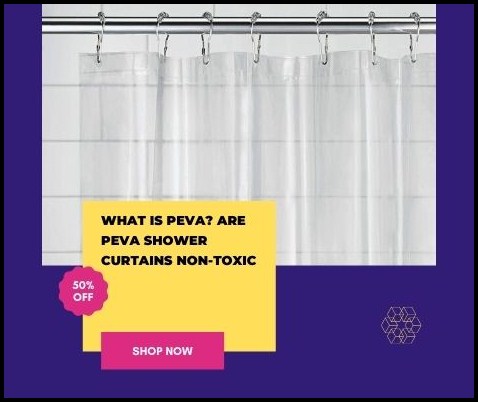
You may not know how much your average household items consist of PEVA. PEVA is a direct substitute for PVC and is use to make all kind of familiar product.
Table of Contents
While it is best known for being used in shower curtains, PEVA is also commonly found in:
- Adhesives and Stickers
- Shoes
- children’s toys
- saddles
- hand covers
- Boots
PEVA is a short form of polyethylene vinyl acetate, while PVC is a short form of polyvinyl chloride, all of which are various forms of vinyl.
Which is better: a PVC or PEVA shower curtain?
PEVA shower curtains are much less harmful than PVC ones. They are chlorine-free, which means they do not discharge poisonous dioxins.
However, PEVA shower curtains still contain toxic VOCs, and we need more research to determine how safe (or dangerous) PEVA is.
In the meantime, browse below for the healthiest, safest PVC and PEVA free shower curtains.
This complete guide is also intended to inform you about which of the feature family products typically contain PEVA and how healthy and balance they are for you and your family member.
I would also like to place a small disclaimer to recommend that you contact a physician if you experience any clinical problems related to getting with a PEVA item.
Since we’ve gotten that off the beaten path, let’s get started!
Read More : ANT radio service? What happens if I uninstall the ANT radio service?
What is PVC?
Conventional shower curtains are made of polyvinyl chloride or PVC. Although PVC surrounds us almost everywhere, it is the most toxic type of plastic.
As its name suggests, PVC contains chlorine, which produces dioxins and furans. These are very poisonous chemicals. According to the World Health and Welfare Company (THAT), dioxins “can cause reproductive and developmental problems, damage the immune system, interfere with hormones, and cause cancer.”
Not only that, but PVC often includes phthalates (which are use to make the plastic more versatile). Phthalates are endocrine disruptors, which can interfere with a person’s natural hormonal function and cause the inability to conceive and develop toxicity. They are also link to diabetes and bronchial asthma problems and can cause cancer.
To make matters worse, heat can release these and other unpredictable organic compounds (VOCs) from plastic, meaning you’re likely to breathe in percentages every time you take a hot shower. These chemicals can build up in your air over time, increasing indoor air pollution and negatively affecting your well-being and your home over an extended period.
What is PEVA used for?
Shower curtains are perhaps the most common polyethylene vinyl acetate product in most families. They are generally observe that chloride vinyl was use instead of PEVA in virtually all shower curtains.
Customer understanding has primarily shifted more towards making healthy lifestyle choices in recent years. Once again, the vast majority of people are already aware of the dangers associated with PVC items.
PEVA shower curtains have recently become a more standard product than their other PVC equivalents. This is mainly because they can be much more eco-friendly and free of odors.
Children’s toys, footwear, makeup bags, children’s bibs, table treatments, fabrics, car covers, cushion covers, and even sometimes electric heaters are all particular examples of everyday family products that may have PEVA.
Some other examples are specialise sports tools such as the use of soccer cleats, professional baseball knee pads, bicycle bands, head guards, occasionally caps, and stickers, plastic mats, decals, and sneakers.
PEVA also has a couple of other uses. It is use to develop packaging for various other products. It is also use for the manufacture of some fabrics and bookbinding. It is more significantly known as a much safer alternative to PVC. However, it is also use as an alternative to many other products ranging from wood to rubber and cork.
Leave a Reply
You must be logged in to post a comment.